Saying goodbye to February
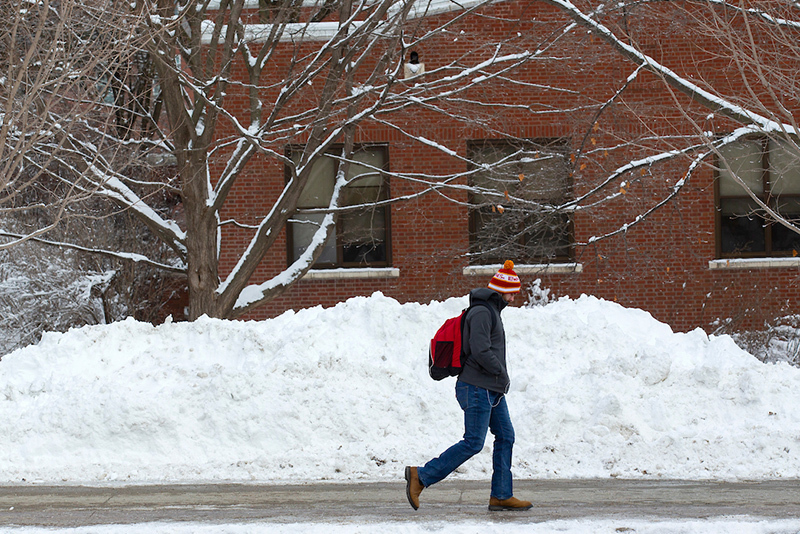
A student passes snow piled high next to the sidewalk near Lagomarcino Hall earlier this week. Photo by Christopher Gannon.
How can the calendar's shortest month own so much snow, you wonder? So do campus services program coordinator Joel Bender and his diligent teams. During February's 20 snowy days, campus services crews logged 7,152 hours on snow removal. The month included eight days of early starts (as early as midnight) to get after the white stuff, and crews worked at least part of three of the month's four weekends.
During February, crews spread 270 tons of rock salt and 100 tons of sand on streets and parking lots. Bender said campus received just over 23 inches of snow in February, compared to January's 14 inches.
March contains 31 days; here's hoping none of them delivers another snowstorm.
Engineering dean finalists will visit campus in March
Five finalists have been selected in the search for the next James L. and Katherine S. Melsa Dean of Engineering. They are scheduled to visit campus in March.
- Candidate 1, March 3-5
- Candidate 2, March 10-12
- Candidate 3, March 13-15
- Candidate 4, March 24-26
- Candidate 5, March 26-28
Each candidate will be announced one business day before his or her visit. The candidates will meet with students, faculty, staff and stakeholders and hold an open forum. Forums will be held from 2 to 3 p.m. in the Howe Hall auditorium on the following dates:
- Candidate 1, Monday, March 4
- Candidate 2, Monday, March 11
- Candidate 3, Thursday, March 14
- Candidate 4, Monday, March 25
- Candidate 5, Wednesday, March 27
Check the provost's office search page for additional details as they become available, including the finalists' curricula vitae and interview itineraries.
The next dean will succeed Sarah Rajala, who announced her retirement in August, effective at the end of this academic year.
Faculty can find answers at Workday forum
A forum designed specifically for faculty will provide a targeted look at how Workday and improved service delivery (ISD) will impact their teaching, research and extension work. FIve sessions of the same faculty forum are scheduled, beginning March 14.
Workday, the software platform ISU will use to do business, goes live July 1, along with the ISD model that created teams of finance and human resources experts to support colleges, departments and units.
Jo Anne Powell-Coffman, professor in genetics, development and cell biology, and David Cantor, professor in supply chain management, helped develop the forum. Both serve as faculty liaisons to the WorkCyte team. They said WorkCyte and ISD leaders will address questions and concerns collected from informational meetings with colleges and departments.
"This is an opportunity for faculty to learn firsthand about all of the changes that will happen on July 1," Powell-Coffman said. "They can learn how Workday operates and how to connect with their service specialists."
All sessions will be held in the Memorial Union, and refreshments will be provided. Dates and times are:
- Thursday, March 14 (11 a.m.-1 p.m., MU Sun Room)
- Tuesday, March 26 (10 a.m.-noon, MU Sun Room)
- Tuesday, March 26 (1-3 p.m., MU Sun Room)
- Tuesday, April 2 (10 a.m.-noon, MU Sun Room)
- Wednesday, April 3 (9:30-11:30 a.m., MU Great Hall)
Bring your questions
Administrative leaders will open each forum with a brief overview of Workday and ISD, followed by a breakout session of interactive table-topic stations. Workday demonstrations and conversations led by ISU experts will focus on:
- Managing grants (post-award)
- Supervising employees (staff and students)
- Processing travel and expenses
- Purchasing equipment, supplies, etc. (procurement)
- Recruiting and hiring personnel
- Choosing B-base appointment salary and benefit options (for example, 12-month pay elections and monthly benefit deductions)
- Navigating Workday
"Each breakout session will follow an interactive discussion format," Cantor said. "The facilitator will explain the functionality of the process in Workday, and there will be demonstrations of how Workday will work. The person leading the conversation will be an expert in that area, so the faculty member can ask any question he or she has about that part of Workday."
Faculty are encouraged to bring their questions and visit as many topic stations as they wish during the breakout sessions.
"Every faculty member will have different things they'll be concerned about. We want them to be able to focus their time on the things that are of the greatest interest and importance to them," Powell-Coffman said. "They can customize their experience and get the information they need."
WorkCyte leaders and ISD specialists also will be on hand to meet faculty and answer questions. Information about support, resources and Workday training -- including computer-based and instructor-led training for faculty -- will be available.
Register now
In a Feb. 26 email, President Wendy Wintersteen encouraged all faculty to register for one of the four faculty forum sessions. Registration is open on Learn@ISU; type "WorkCyte faculty forum" in the keyword search.
Questions can be emailed to WorkCyte_Change@iastate.edu.
Teaching assessment methods may soon broaden
Using several methods to evaluate faculty teaching effectiveness, instead of relying principally on student ratings of instructors, will be one focus of a set of recommendations expected later this spring from a task force studying how to improve teaching assessment.
After meeting throughout the academic year and studying similar efforts at other institutions, the joint task force -- a collaboration between the Faculty Senate and the provost's office, via the Center for Excellence in Learning and Teaching (CELT) -- has agreed on the broad strokes of its proposal. The underlying intent is to encourage a multipronged approach to teaching evaluations -- holistic deliberation common in promotion and tenure reviews but not always in annual evaluations or faculty awards decisions.
"There's a reason why we put multiple legs on a chair," said genetics, development and cell biology professor Jo Anne Powell-Coffman, a member of the task force.
Task force members
- Jonathan Sturm, Faculty Senate (co-chair)
- Sara Marcketti, CELT (co-chair)
- Zahra Barkley, Student Government
- Jan Boyles, LAS
- David Cantor, Business
- Norin Chaudhry, Graduate and Professional Student Senate
- Amanda Fales-Williams, Vet Med
- Rose Martin, Human Sciences
- Michael Muecke, Design
- David Peterson, LAS
- Jo Anne Powell-Coffman, AgLS
- Diane Rover, Engineering
- Henry Schenck, LAS
The 13-member task force, which includes two students, a department chair and former chair, and current faculty, is intended to generate the widest possible perspective and input on the issue of faculty evaluation. It aims to make teaching evaluation more meaningful, timely and fair to all, improving the quality of teaching at Iowa State while disenfranchising no one.
The group is still working on specific recommendations, which it expects to release in late April for the Faculty Senate to consider during the 2019-20 academic year, said task force co-chair Jonathan Sturm, a music professor and the faculty senate's president-elect. But Sturm and co-chair Sara Marcketti, CELT director and professor in apparel, merchandising and design, outlined three areas the recommendations will touch on.
Rethinking student ratings
One set of recommendations will suggest best practices and guidelines for administering and using student ratings, which students voluntarily submit after completing a course. Researchers say the evaluations can show signs of gender and racial bias. The task force doesn't plan to call for eliminating student evaluations, however.
"They're consumers, and their opinion is valid. We want to always have that as an included part of this process. But is that the only thing we want?" Sturm said.
As part of an Association of American Universities grant to support undergraduate STEM education, Powell-Coffman brought two experts to campus last fall to present to the task force, including Marcketti's counterpart at Wake Forest University, Winston-Salem, Betsy Barre, who encouraged continuing to use student feedback. Despite their flaws, Barre told the task force, student ratings remain an important piece of evidence.
In addition to establishing parameters for using student ratings, Marcketti said, the task force may suggest changes related to how and when the data is shared with faculty. Practices vary between departments, and consistency would be valuable, she said.
Widening the lens
Urging departments to use a rubric scoring system to evaluate a broad spectrum of teaching data would ensure student ratings don't become the sole measurement by default. Some departments already take a wider lens in teaching assessment, using various methods, Marcketti said.
"In the absence of other forms of assessing teaching effectiveness, it often comes down to that one student evaluation of teaching number," she said.
Other annual evaluation approaches already adopted by peer institutions could include reviewing syllabi, peer observation and self-reflection.
The additional work this could add for faculty may prompt concerns, but Marcketti said the task force is taking thoughtful approaches to demands on time. A more involved plan for evaluating teaching likely would streamline over time, Sturm said. The rubric also will help speed the process, Powell-Coffman said. It is easier to review colleagues' course materials or observe them in the classroom when the assessments are based on quantitative scoring, she said.
The other expert who presented to the task force was Andrea Greenhoot, director of the Center for Teaching Excellence at the University of Kansas, Lawrence, where several departments are using rubric systems to broaden their teaching evaluations. A big takeaway from Greenhoot was to allow departments to set their own rubrics, based on what they value and the nature of their courses, Powell-Coffman said.
"Just to be having those conversations is good for the program, and to have clarity on those issues is good for the faculty," she said.
Handbook review
The third area the task force plans to address is the faculty handbook section on teaching evaluation. Proposed additions could, for instance, provide guidance to both faculty and department chairs on how to document effective teaching and the role of student ratings in that process, Marcketti said.
For more information
Faculty or staff who want to provide input to the task force can contact any member or email Sturm at jsturm@iastate.edu or Marcketti at sbb@iastate.edu. An open forum for faculty to weigh in on the proposal will be held after the recommendations are released.
Five questions with the vice president for diversity and inclusion
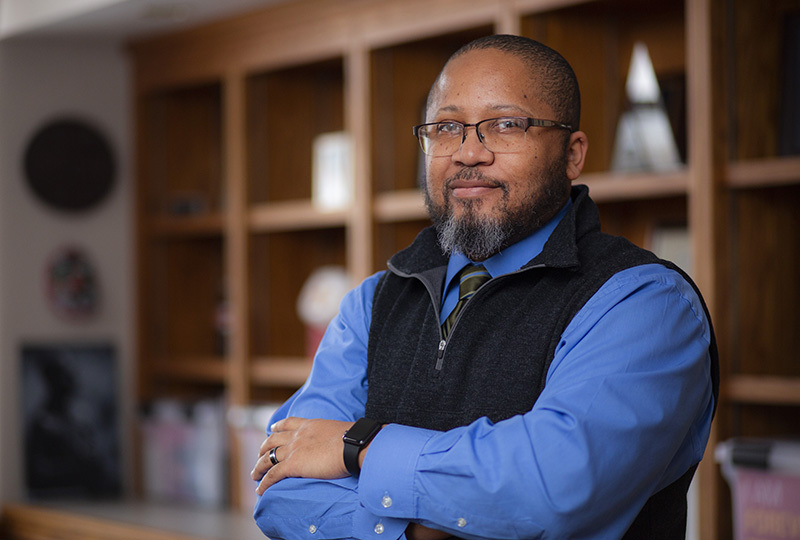
Reginald Stewart, vice president for diversity and inclusion, in his office in Beardshear Hall. Photo by Christopher Gannon.
Reginald Stewart has worked on diversity and inclusion on college campuses for 30 years, since his time in the disability services office as a San Francisco State University undergraduate. Years ago, people would sometimes ask, "Do you really still need to do diversity work?"
"Nobody asks me that anymore," said Stewart, vice president for diversity and inclusion.
While striving to make campus welcoming to all is more urgent than ever, Stewart has shown in his three years as Iowa State's first chief diversity officer how vital that work is off-campus, too. He was honored last month with the Ames Human Relations Commission's 2019 Humanitarian Award in recognition of his work on numerous initiatives with the city and area nonprofits, including a four-week program teaching underrepresented residents about municipal government and a symposium for local business leaders on building inclusive organizations.
The basics
Name: Reginald Stewart
Position: Vice president for diversity and inclusion
Years at ISU: 3
Education: Bachelor's in sociology, San Francisco State University; master of education in educational leadership and doctorate in higher education administration, University of Nevada
In a recent interview, Stewart talked about his experience and approach as the university's inaugural diversity executive -- a position he also was the first to hold at the University of Nevada, Reno.
What have you done here that you're most proud of?
If I had to quantify what I'm most satisfied with, it'd be successfully installing this position. It's a very high-level job that many campuses have had for years. But with it being new at Iowa State, there's a lot of social capital to be built. There's a lot of nurturing of relationships. There's a lot of building trust so that when you start to install systems, they can be installed really fluidly. Everyone has their own expectations for what a role will be if the role is not defined. So you're meeting people where they're at and talking through and explaining how this job will maybe do parts of what they expect, but there's a bigger strategic operation at play. Often times, their expectations are echoed or mirrored in other places, and that gives you some concrete building blocks. When I first got to campus, people said the university administration was too slow to respond to incidents. That was a big, resonating message. We realized you're not going to be able to increase your response time unless you install an accelerator. So we built the campus climate response team. We hear less of that critique now, and it's because we built an entire mechanism comprised of invested stakeholders who focus on being responsive.
Why is trust so important to the work your office does?
The topics we discuss are very sensitive. They're very polarizing. They're things many people have been socialized not to talk about. So the trust has to come from a person who's going to lead you on a conversation that could be uncomfortable, that you feel like you don't have enough information to weigh in on. I always say when I'm giving talks on campus, "You are an expert in your own experience." You get to bring that to this conversation. The objective here is not to leave thinking we're in lockstep. The objective is to say, "Here's the issue we need to work on. This is the problem we need to figure out. And we need both of us and our worldviews to fix this." I think coming from that direction gives people a level of trust. "Oh, OK, this guy's not going to be preachy. He's not going to be condescending. He's not going to beat me up for what I don't know." But understand: Your normal and my normal are not mutually exclusive. Your identity is not the default setting for how people should live. I think if you can get there, that level of trust builds on itself.
Was adding more staff at the top of your priorities?
There are really two approaches you can use to institutional diversity and inclusion. There's advocacy work and compliance work. We needed to focus on compliance first. Nationally, when people talk about what's happening to them -- whether it's harassment, discrimination, sexual assault -- what you often hear is some version of, "I'm displeased with the institution's response to what happened." That's part of your compliance work. It was important that we place focus on building a responsive team. Your advocacy work gets out in front and teaches people how to build a better climate so, hopefully, we can do less responding and more engagement. We need to broaden the umbrella of those doing the teaching, the training, the work to model the appropriate behaviors and the constructive way to engage with people to create inclusive environments and workplaces. The next three years is really about increasing advocacy. Fortunately, we have been able to build a framework for enterprise-wide advocacy work. What we did with our Latinx affairs and with our LGBTQIA affairs has resulted in stronger collaborations among faculty, staff, students and community members. I would like to be able to replicate that success with work in Pan-African affairs, our work with Asian-American and Pacific Islander initiatives, and our work with Native American/American Indian advocacy and support efforts. Those are three priority advocacy areas that I'd like to be able to set people about doing constructive work on.
How important is it for a person in your role to be involved in the community, to be a voice for diversity not just on campus?
Our role as a land-grant university is to provide this beacon of leadership, research, scholarship and teaching, and share it with the community. So why would that stop with diversity and inclusion? Why would you only keep this forward progress limited to campus? It's counterintuitive to what a land-grant is about. And moreover, the people who work and go to school here don't just stay on central campus. They live and work in the community. You're only having half the conversation if you're only talking about their campus experience. The VPDI role should be a conduit of inclusion from campus to the community. You're working with community agencies and city managers and mayors and chambers of commerce to get everyone -- whether that's industry, whether that's visitors, you name it -- talking about creating a more inclusive world to live in. We get to lead that conversation. Not every entity has the opportunity to hire an executive-level diversity strategist. And in reality, they don't all need to if your public university is willing to lend its time and energy.
In what ways are things getting better at Iowa State?
At Iowa State, people don't shy away when you reach out and say, "Hey, there's an initiative we want to work on, I need you." The state of Iowa has a strong record of being progressive, and considering the very homogeneous population, it's impressive. I think Iowa State mirrors that. Not in total -- we definitely have our incidents where people just want to be disruptive. But I see Iowa State folks invested in this institution. They don't want things to mar the pride they feel about being a Cyclone. If it means investing with both hands in diversity and inclusion, they're willing to do it because they hold such an affinity for this institution. I think that's a wonderful place to be.
West campus road, utility projects resume in March
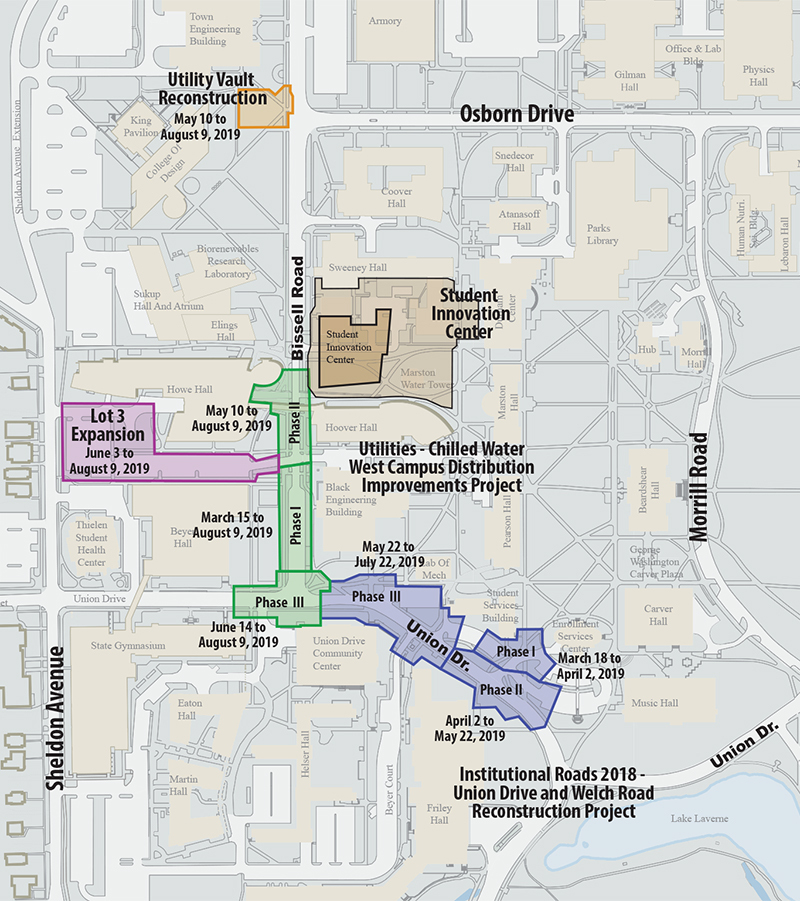
A second round of utility and road replacement work on the west side of campus will be phased this spring and summer. Image courtesy of facilities planning and management.
Work resumes in mid-March on several west campus road replacement projects that include underground utility work. As occurred last spring and summer, the projects will close sections of Bissell Road and Union Drive in phases. By its targeted mid-August completion date, numerous improvements should be done:
- Large chilled water pipes will be added beneath Bissell Road between Osborn and Union drives, expanding the capacity of the 50-year-old system in this area of campus. Buildings in the west and southwest parts of campus will be much easier to cool.
- Larger storm sewer lines will be installed beneath Bissell and Union between Osborn and College Creek. This will replace an undersized 78-year-old storm sewer installed when west campus was mostly undeveloped.
- In concert with the utility work, sections of Union, Bissell and Welch roads will be removed and reconstructed. (The Welch Road and north Bissell work was completed last summer.) The new narrower roads and wider sidewalks are designed for pedestrian safety and comply with federal accessibility requirements.
Phased work on two roads
The Bissell and Union projects each have three scheduled phases this summer but keep their own timeline. Weather permitting, Bissell's phase 1 closes the stretch of road west of Black Engineering (excluding intersections at both ends) on Friday, March 15. Parking lots 3 (south and west of Howe Hall) and 8 (north of Black Engineering) remain accessible from the north on Bissell through spring commencement weekend. On May 10, a second section of Bissell -- roughly in front of Howe Hall -- will close. Phase 3, from approximately mid-June to early August, will remove the Bissell Road-Union Drive intersection, with all three phases rebuilt near the end of the summer timeline. In effect, Bissell will be closed to through traffic from spring break through early August.
The Union Drive first phase won't impact the road. Beginning March 18 and lasting for about three weeks, the entrance to the north half of parking lot 65 (Enrollment Services Center) will close to create a future single entrance to lots 65 and 5 (Student Services) and realign sidewalks in that area. Phase 2, from early April to late May, closes a section of Union Drive just north of Welch Road as well as access to the south half of lot 65. Phase 3, beginning in late May, will close access to parking lot 4 (Lab of Mechanics), Beyer Court (between Friley and Helser halls) and permanently remove the current entrance to lot 5. Impacted sections of Union Drive will reopen as phases 2 and 3 conclude.
Angie Solberg, facilities planning and management project manager on the Welch Road-Union Drive reconstruction, said there will be a pedestrian walkway on one side of Union Drive and Bissell Road throughout the project, with road crossing zones well marked.
The finished product
When fall semester begins, the road corridor from the Bissell/Osborn intersection south to the Lincoln Way/Welch intersection will look and function consistently. Road widths will narrow from as wide as 40 feet to a uniform 27 feet, and sidewalks will widen to 10 feet. A single traffic lane in each direction (13.5 feet wide) will be shared by vehicles, buses and bicycles. The Union Drive bus stop near the Enrollment Services Center will be consolidated with the larger stop near Lab of Mechanics, and lighting and landscaping throughout the corridor also will be replaced.
"The priority of the road work is to protect pedestrians in some very heavily traveled zones," Solberg said.
Nearby summer projects
- Expanding and improving lot 3 (south and west of Howe) is a separate project but will begin June 3. The project adds 17 parking stalls, improves storm water management and replaces lighting. The lot will be offline through early August.
- Reconstructing an underground utility vault west of the Bissell Road-Osborn Drive intersection (May 10-Aug. 9) will reroute pedestrians in that area but shouldn't impact vehicle traffic.
Tap Room provides space to focus on mental health
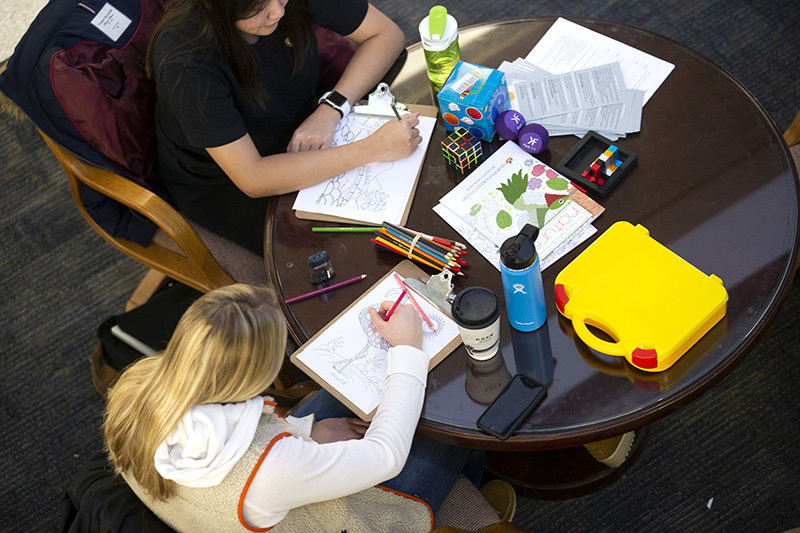
Peer wellness educators and ISU seniors Diane Tan (top) and Madison Hemer use coloring sheets at the Tap Room for student mental health wellness at Parks Library. Photo by Christopher Gannon.
Finding time in a day to get everything done can be a challenge. Finding time for mental health can feel like the last thing on a long to-do list.
Student wellness has a new outreach program called the Tap Room that provides a space for students, faculty and staff to take part in activities that promote relaxation, mindfulness and good mental health.
The Tap Room is a play on words with the idea to "make room to tap into you."
"Universities are looking to create places for people to relax," said Brian Vanderheyden, assistant director for student wellness. "The goal is to have people go in there to focus on themselves and take a break."
How it works
The Tap Room sets up a spot on the ground level in Parks Library each Monday, Tuesday and Thursday from 11 a.m. to 1 p.m.
Depending on the size of the space, various stations are set up for self-directed use in guided meditation, biofeedback, light therapy, aromatherapy, mind puzzles and more. All activities have directions and allow users to go at their own pace.
Vanderheyden said conference rooms and lounges work best, but anywhere away from high-traffic areas is preferred.
One of the advantages of the Tap Room is its mobility. Any student organization, faculty, staff or department can request the room come to a campus location by filling out an online request form. Vanderheyden asks for 14 business days notice to coordinate and ensure best results.
"We bring the equipment and set it up. People can use it for as long as it is there -- anywhere from two hours to a day," Vanderheyden said. "This can be connected to other programs. If an event is going on and you want people to be able to go in and out, it can be used in a variety of ways."
When participants conclude their exercises, they are given a feedback survey and information on mental health resources.
The lessons learned can be applied long after leaving.
"These are all practical things that people can do and practice on their own," Vanderheyden said. "With a lot of these things, it takes practice over time, and doing this once is not going to change everything. Just like physical exercise, you have to do the same things with mental health."
Room to grow
The Tap Room program, which began in February, is coordinated by Peer Wellness Educators -- student employees in student wellness. They spent fall semester researching what other colleges and universities were doing to improve mental health and developed a plan.
The long-term goal is to create several permanent spaces across campus.
"We would like a couple of permanent spaces, but we would still be mobile," Vanderheyden said.
Brunnier Museum renovation is ready to begin
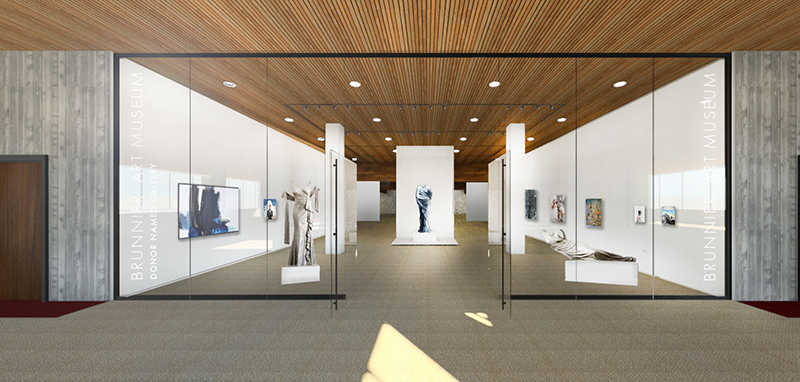
By August, the Brunnier Art Museum should feature a new exhibition gallery behind a front glass curtain wall. Architect rendering provided by University Museums.
Demolition has begun quietly on the east side of the Scheman Building's top floor, but following a Feb. 28 reception for donors, the Brunnier Art Museum entrance will be encased in plywood and a five-month renovation will take off.
The $1.95 million project will:
- Install a glass wall entrance for the museum onto the Scheman second-floor atrium
- Create space for an 1,800-square-foot front gallery
- Purchase a space-conserving storage system for the museum's collection vault
- Replace the heating/cooling system, to protect the collection and keep visitors and staff more comfortable
- Consolidate staff offices on the north side of the museum
University museums director Lynette Pohlman said the storage vault should be useable by the end of May. The rest of the renovation is slated for completion around Aug. 1, giving staff several weeks to move back in and install fall exhibitions. An opening reception is scheduled for Sept. 19.
Pohlman speaks with enthusiasm about the additional front-and-center exhibition gallery, which will be named in memory of alumna Lori Jacobson, a Roland native who interned in university museums in the late 1970s as an undergraduate and went on to a career in museum management. Pohlman said the compact storage system will significantly reduce the staff time needed -- from hours to minutes -- to retrieve pieces from the 20,000-piece Brunnier Museum collection. It also will create 30 percent more storage space on the same footprint.
Funding for the project includes $1.2 million in private gifts and $600,000 from university museums' unrestricted Fund for Excellence. The heating/cooling component will be covered with $170,000 from the university's Facilities Overhead Use fund.
Museums staff have relocated to temporary spaces around campus, but their phone numbers and email addresses remain the same.
The Brunnier hasn't had public exhibitions since January 2018, but staff continue to provide pieces from the collection for classes and research projects. Fundraising and project planning also continued during this time. University museums' other indoor museums, Farm House Museum and Christian Petersen Art Museum in Morrill Hall, remain open.
